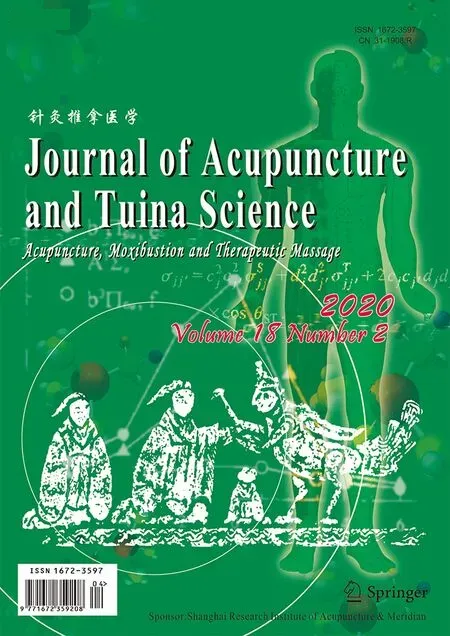Therapeutic observation of arthrolysis under brachial plexus anesthesia for adhesive capsulitis of the shoulder
2020-04-21FanYuanzhi樊远志WuYaochi吴耀持
Fan Yuan-zhi (樊远志), Wu Yao-chi (吴耀持)
Department of Acupuncture, Tuina and Traumatology, Shanghai Jiao Tong University Affiliated Sixth People’s Hospital, Shanghai 200233, China
Abstract Objective: To objectively evaluate the short-term and long-term efficacies of arthrolysis under brachial plexus anesthesia in treating adhesive capsulitis of the shoulder (ACS).Methods: One hundred patients diagnosed with ACS were divided into two groups using the random number method.The two groups both received same active rehabilitation exercises. Besides, 55 cases in the treatment group were given one session of arthrolysis under brachial plexus anesthesia, and 45 cases in the control group were given tuina treatment. Changes in the visual analog scale (VAS) score, Melle score and pressure pain index were observed 1 month and 3 months after treatment. The therapeutic efficacies were also compared.Results: The total effective rate was 96.4% at the 1-month follow-up and 96.4% at the 3-month follow-up in the treatment group. The total effective rate was 33.3% at the 1-month follow-up and 28.9% at the 3-month follow-up in the control group. There were significant differences between the two groups comparing the total effective rate at the two time points (both P<0.05). The scores of VAS, Melle and pressure pain were significantly different at the 1-month and 3-month follow-ups from those before treatment in the treatment group (all P<0.05); the three scores did not show significant differences at the 1-month and 3-month follow-ups compared with those before treatment in the control group (all P>0.05).Conclusion: Based on the active rehabilitation exercises, one session of arthrolysis under brachial plexus anesthesia can release the adhesion and restore the range of motion and function of shoulder joint in ACS patients. It is superior to rehabilitation exercises plus tuina treatment comparing both short-term and long-term efficacies.
Keywords: Tuina; Massage; Arthrolysis; Frozen Shoulder; Shoulder Pain; Periarthritis; Brachial Plexus Anesthesia; Range of Motion, Articular
Adhesive capsulitis of the shoulder (ACS), or capsulitis of the shoulder (CS) in adhesion stage, is a common and severe type of CS, mainly manifested as pain and dysfunction of the shoulder joint. If the adhesion is not released, it will significantly affect the upper-limb function, causing difficulties in daily activities[1].Currently, treatments targeting ACS include acupuncture-moxibustion[2], needle knife[3], tuina[4],medication[5], physical therapy[6], functional exercises[7]and arthroscopy[8]. We adopted arthrolysis under ultrasound-guided brachial plexus anesthesia to treat ACS and achieved certain effects in reducing adhesion,restoring joint movement and improving the shoulder joint function. However, adhesion may recur among those who do not practice enough functional exercises[9-10].
This study observed the short-term and long-term efficacies of active functional exercises plus arthrolysis under brachial plexus anesthesia in treating ACS by taking active functional exercises plus tuina manipulations as the comparison. The report is given as follows.
1 Clinical Materials
1.1 Diagnostic criteria[11]
Slow onset, with persisting pain worse at night and affecting sleep; functional dysfunctions: limited range of motion when lifting, abducting and rotating the shoulder, especially in outward rotation; limited movements in daily activities; tenderness in a wide range; tenderness in the anterior side of shoulder,coracoid process, sulcus between acromion and tubercle, deltoid muscle attachment, the interiorsuperior angle of scapula, and between the scapular bones, etc.; shoulder could not drop down, the typical sign of CS; muscle atrophy, which may be found in deltoid muscle, supraspinatus, and infraspinatus. MRI examination indicated adhesion in the shoulder joint.
1.2 Inclusion criteria
Conformed to the diagnostic criteria of ACS in frozen stage; aged 40-65 years old; disease duration between 3 months and 1 year; the subjects were willing to participate and signed the informed consent inform.
1.3 Exclusion criteria
Breast-feeding or pregnant women or women who planned for pregnancy; acute shoulder joint injury,tuberculosis, tumor or rheumatoid arthritis of shoulder joint; cardiovascular or cerebrovascular diseases; severe diseases involving liver, kidney or hemopoietic system;mental disorders; severe osteoporosis or CS without adhesion; rotator cuff injury.
1.4 Statistical methods
The SPSS version 17.0 software was used for statistical analysis. The between-group comparisons of age, disease duration, pain score, Melle score and pressure pain score were performed using t-test;Chi-square test was used to compare the efficacy between the two groups. The significance level was defined as a=0.05, and P<0.05 indicated statistical significance.
1.5 General data
Random number table method was used for randomization based on visiting sequence. The table was designed for 120 cases, and 100 cases were finally recruited, including 55 cases in the treatment group and 45 cases in the control group, who were all diagnosed with ACS between January 2012 and December 2018.There were 38 males and 62 females, whose age ranged between 40 and 65 years old at an average of(54.14±6.34) years old, and disease duration ranged between 2 months and 2 years. The between-group comparison of age showed t=-0.93, P=0.350, and the between-group comparison of the mean disease duration showed t=-0.05, P=0.950, without statistical significance, indicating that the baselines were at similar levels (Table 1).

Table 1. Comparison of general data
2 Treatment Methods
The two groups all practiced active rehabilitation exercises under professional guidance following the manipulation treatment.
Wall climbing with both hands: When standing facing to the wall, the patient put both hands onto the wall,and the fingers of the affected side gradually ‘climbed’up with support of the healthy arm. With all the effort,tried to raise the affected arm as high as possible, better parallel to the wall, and then gradually put it down.Repeated this exercise several times.
Backward extending both arms: Either standing or sitting, the patient slowly rotated forward and extended backward the affected arm, and pulled the affected arm towards the healthy side with the healthy arm from behind, trying to reach the contralateral scapula.
Lifting over the head: Either standing or sitting, the patient grasped the wrist of the affected arm with the hand of the healthy side and lifted the affected arm in front of the chest, over the head till reaching the occiput. Practiced this movement repeatedly like combing the hair.
The patients were required to practice the exercises 3 times a day, 20-30 min each session, with 7 d as a course.
2.1 Treatment group
Patients in the treatment group received arthrolysis under ultrasound-guided brachial plexus anesthesia.The ultrasound-guided brachial plexus anesthesia was conducted by a physician from the Pain Department.The arthrolysis was performed by the physician from the Department of Acupuncture, Tuina and Traumatology when anesthesia started to take effect.
Ultrasound-guided brachial plexus anesthesia: With a cushion under the neck and shoulder, the patient lied on the back and turned his head towards the healthy side to best expose the neck from the affected side.After interscalene sterilization, 20 mL of 1.5% lidocaine was injected when there was a sensation of electric shock, with the needle tip towards the affected shoulder, for brachial plexus anesthesia. The arthrolysis began only when anesthesia was satisfactory[12].
Arthrolysis: The patient took a supine position, with the affected shoulder joint interiorly rotated and elbow bent by 90° attaching to the chest (Figure 1). Lifted the shoulder till over the head with the arm resting on the bed (Figure 2). Bent the elbow by 135° between the arm and the medial axis (Figure 3). Lifted the arm again and then extended it till 90° to the medial axis (Figure 4).The patient then lied on his side, extending straight the affected arm and passively reached it back till the maximal range (Figure 5). Bent the elbow of the affected side, with the back of the hand closely touching the back and the thumb at the level of T6-T7(Figure 6). In the end, the elbow of the affected side bent by 90° and fixed attaching to the chest(Figure 7)[13].
The treatment group only received 1 session of arthrolysis under anesthesia, and the active rehabilitation exercises started the next day.
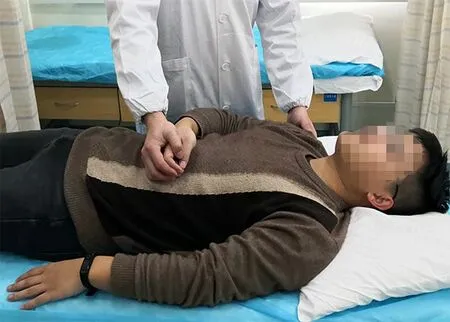
Figure 1. Bending the elbow

Figure 2. Lifting and extending the arm over the head

Figure 3. Bending the elbow till 135° to the medial axis

Figure 4. Extending the arm by 90° to the medial axis

Figure 5. Backward extending and laterally rotating the arm
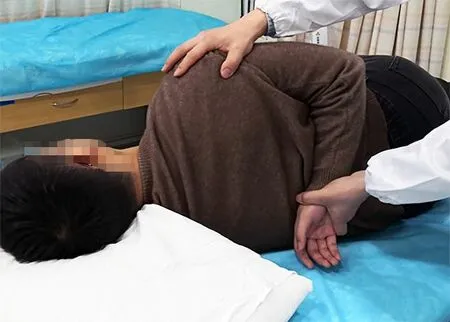
Figure 6. Bending the elbow, and backward extending,laterally rotating and lifting the arm
2.2 Control group
Patients in the control group received tuina manipulations. Patient took a sitting position. The physician applied Rou-kneading, Gun-rolling and Na-grasping manipulations from shoulder to hand repeatedly for about 20 min (Figure 8). Patient was made to lift, backward extend, laterally extend and rotate the arm within his endurance. Gradually increased the range of motion, lasting for about 5 min(Figure 9 and Figure 10).
The tuina treatment was conducted once every other day, 25 min each time, with 7 sessions as 1 course.
3 Evaluation of Therapeutic Efficacy
The therapeutic efficacy was evaluated after 7-day treatment. The patients were asked to practice the active rehabilitation exercises mentioned above at home after 1 course of treatment. Follow-ups were conducted at 1 month and 3 months at clinic.
3.1 Observation items
3.1.1 Score of pain
Subjective pain intensity was measured using visual analog scale (VAS). Painless: VAS score 0-1 point (not including 1 point); mild pain: VAS score 1-4 points,recorded as 1 point; moderate pain: VAS score 5-7 points, recorded as 2 points; severe pain: VAS score >7 points, recorded as 3 points.
3.1.2 Score of shoulder joint function and movement
Melle score was adopted for quantitative evaluation of 5 movements of the shoulder.
Lateral extension: <30° scored 3 points; 30-90° scored 2 points; >90° scored 1 point.
External rotation in neutral position: <0° scored 3 points; 0-20° scored 2 points; >20° scored 1 point.
Hand reaching the neck: ‘Cannot’, scored 3 points;‘difficult’, scored 2 points; ‘easy’, scored 1 point.
Hand reaching the spine: ‘Cannot’, scored 3 points;‘difficult’, scored 2 points; ‘easy’, scored 1 point.
Hand reaching the mouth: Complete trumpet sign,scored 3 points; partial trumpet sign, scored 2 points;shoulder adduction <40°, scored 1 point.
3.1.3 Pressure pain index score
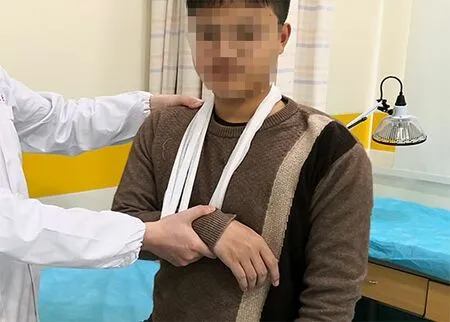
Figure 7. Bending the elbow and fixed it attaching to the chest
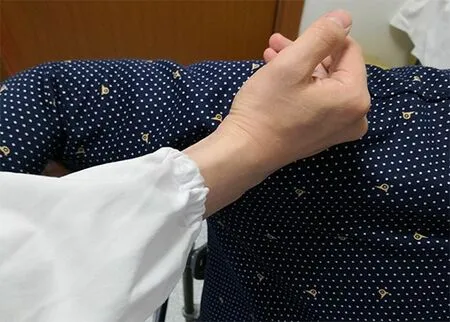
Figure 8. Gun-rolling manipulation
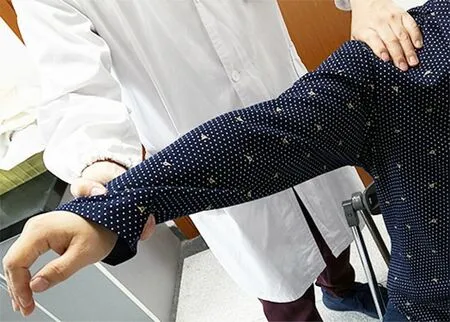
Figure 9. Lateral extension

Figure 10. Bending the elbow and backward extending,laterally rotating and lifting the arm
M-tone digital pressure pain tester (Tianjin Mingtong Century Technology Co., Ltd., China) was used to measure the pressure pain. After calibration of the device, the physician first found the tender points around patient’s shoulder by the thumb and measured the most sensitive points. The pressure value that initially triggered pain was recorded. Same point was measured throughout the study. This device releases pressure onto local soft tissues and determines the pain threshold by the pressure reading. The higher the pressure tolerated, the higher the pain threshold. This test offers objective data and thus is more precise than patient’s subjective feelings. To reduce error, 2 trained researchers were in charge of the testing.
3.2 Criteria of therapeutic efficacy
The criteria were made by referring the Shanghai Diagnosis and Treatment Standards for Diseases and Syndromes in Traditional Chinese Medicine[14].
Cured: Shoulder pain was gone, and shoulder joint function was completely or partially recovered.
Improved: Shoulder pain was reduced, and shoulder joint function was improved.
Invalid: The symptoms and signs did not show improvement.
3.3 Treatment results
3.3.1 Comparison of therapeutic efficacy
By Chi-square test, the between-group comparison of total effective rate at the 1-month follow-up showed χ2=9.09, P=0.005, and it was χ2=0.21, P=0.000 at the 3-month follow-up; there were significant betweengroup differences in the total effective rate at the two time points (both P<0.05). By Chi-square test, the between-group comparison of cure rate at the 1-month follow-up showed χ2=59.41, P=0.000, and it was χ2=78.90, P=0.000 at the 3-month follow-up; there were significant between-group differences in the cure rate at the two time points (both P<0.05). These results indicated that the therapeutic efficacy was better in the treatment group than in the control group (Table 2 and Table 3).
3.3.2 Comparison of the VAS score
The VAS scores at the 1-month and 3-month follow-ups were significantly different from the baseline score in the treatment group (both P<0.05). The VAS score did not show significant changes at the follow-ups compared with the score before treatment in the control group (both P>0.05). There were significant differences comparing the VAS score between the two groups at the follow-ups (P<0.05). It suggested that arthrolysis under ultrasound-guided brachial plexus anesthesia plus active rehabilitation exercises can significantly reduce the pain in ACS, and can produce more significant short-term and long-term analgesic effects compared with conventional tuina manipulations plus active rehabilitation exercises(Table 4).

Table 2. Comparison of therapeutic efficacy at the 1-month follow-up (case)

Table 3. Comparison of therapeutic efficacy at the 3-month follow-up (case)

Table 4. Comparison of the VAS score (x ±s, point)
3.3.3 Comparison of the Melle score
The Melle scores at the 1-month and 3-month follow-ups were significantly different from the baseline score in the treatment group (both P<0.05). The Melle score did not show significant changes at the follow-ups compared with the score before treatment in the control group (both P>0.05). There were significant differences comparing the Melle score between the two groups at the follow-ups (P<0.05). It suggested that arthrolysis under ultrasound-guided brachial plexus anesthesia plus active rehabilitation exercises can significantly improve the shoulder joint function in ACS,and can produce more significant short-term and longterm improving effects compared with conventional tuina manipulations plus active rehabilitation exercises(Table 5).
3.3.4 Comparison of the pressure pain index score
The pressure pain scores at the 1-month and 3-month follow-ups were significantly different from the baseline score in the treatment group (both P<0.05).The pressure pain score did not show significant changes at the follow-ups compared with the score before treatment in the control group (both P>0.05).There were significant differences comparing the pressure pain score between the two groups at the follow-ups (P<0.05). It suggested that arthrolysis under ultrasound-guided brachial plexus anesthesia plus active rehabilitation exercises can significantly increase the pressure pain score in ACS. The results showed that the treatment group was superior to the control group comparing both the short-term and long-term effects in improving the pressure pain score (Table 6).

Table 5. Comparison of the Melle score (x ±s, point)

Table 6. Comparison of the pressure pain index score (x ±s, point)
4 Discussion
4.1 Pathological features of ACS
ACS is one type of frozen shoulder and a pathological extension of ordinary frozen shoulder, presenting worse symptoms and signs including loss of shoulder joint function. The cause of this condition is still unclear,though imaging tests reveal chronic strain or damage of soft tissues around the shoulder joint, supraspinatus tendonitis, biceps tenosynovitis, and subacromial bursitis, which all involve the joint capsule and may induce chronic inflammation and adhesion in the capsule. In the elderly, synovial hypertrophy and smaller synovial bursa caused by osteoporosis and ligament calcification also play a role in the development of shoulder joint dysfunction[15]. Furthermore, acute traumas like abrasion, fracture and dislocation that affect the shoulder joint may also lead to adhesion in shoulder joint capsule and soft tissues around the shoulder joint due to inflammatory exudates, pain,muscle spasm and long-time fixation[16]. But this type should be treated with surgery plus rehabilitation, and is not in the range of the current study. ACS presents a progressive aggravation and aseptic inflammation exists throughout the whole process. Therefore, antiinflammation, killing pain and releasing the adhesion should be the main principle in tuina treatment of this disease[17-18].
4.2 Key points in conservative treatment of ACS
It has reached the consensus to treat ACS through releasing adhesion[19-20]. Although conservative monotherapy such as acupuncture-moxibustion, tuina and needle knife can cease pain and release the adhesion, they usually take a long painful process and may affect the quality of life. Indeed, conservative treatment can avoid surgical trauma and anesthesia accidents, but the sufferings experienced through the treatment cannot be ignored. It is necessary to reduce and eliminate the sufferings in the development of medicine, which also is the best reflection of humanistic care. Hence, a conservative treatment that can not only reduce the suffering and shorten the treatment duration but also rapidly enhance the therapeutic efficacy is worth recommending, such as the arthrolysis under brachial plexus anesthesia introduced in this study.
4.3 Advantages of arthrolysis under brachial plexus anesthesia in treating ACS
Brachial plexus block is commonly used in anesthesiology department. When guided by ultrasound, brachial plexus anesthesia becomes more precise and efficient. Nerve block relaxes the shoulder muscles and puts the adhesive joint under anesthesia,which can avoid the resistance-caused injuries to muscles, tendons, joint capsules, nerves and vessels during tuina treatment. It allows patients to receive treatment without pain, reduces suffering experience and fear, and guarantees the safety and compliance[21].The whole set of passive movements used in the arthrolysis, including lifting, laterally extending,backward extending, and backward adducting the arm,can thoroughly release the adhesion in the shoulder joint and restore the joint function. The movements were all in the normal range of motion, to avoid possible injuries to muscles, tendons, joint capsules,nerves and vessels. Timely rehabilitation exercises following the arthrolysis can increase the joint mobility,avoid a second adhesion, promote blood circulation in the joint, reduce inflammatory reactions, and encourage the recovery of atrophic muscles. The arthrolysis introduced in this study is a distinctive technique in our department and has been practiced for many years. The experience and level of the arthrolysis practitioner is another key factor affecting the therapeutic efficacy. Therefore, it was only conducted by senior physician with a title of associate chief physician or higher to ensure the safety and therapeutic efficacy. The results of current study showed that arthrolysis under ultrasound-guided brachial plexus anesthesia plus active rehabilitation exercises produced more significant short-term and long-term efficacies compared with conventional tuina manipulations plus active rehabilitation exercises in treating ACS.
4.4 Effect of post-operation functional exercises on long-term rehabilitation
The rehabilitation exercises started from the next day of the arthrolysis. The purpose was to stretch and relax the soft tissues around the shoulder joint such as joint capsule, rotator cuff, tendons and muscles in the early stage, to prevent a second adhesion. Clinical observation found that early-stage rehabilitation exercises can help restore the flexion and extension of shoulder joint, reconstruct the joint capsule, recover the elasticity of ligaments and absorb the inflammatory products. The 3-month long-term observation found that arthrolysis combined with active rehabilitation exercises produced significant effects in both recovering joint function and preventing recurrence[22].
This study indicated that arthrolysis under brachial plexus anesthesia was a safe, painless and easy-to-operate treatment that can thoroughly release the shoulder joint adhesion without causing accidental injuries. Compared with conventional tuina treatment,it took shorter treatment duration but produced significant and lasting therapeutic efficacy. Therefore,this method is worthy of widespread clinical use.
Conflict of Interest
There is no potential conflict of interest in this article.
Acknowledgments
This work was sponsored by Shanghai ‘Xing Lin Xin Xing’ Plan ( 上 海 市“ 杏 林 新 星” 计 划, No.ZY3-RCPY-2-2034); Special Program of Traditional Chinese Medicine of Shanghai Municipal Health and Family Planning Commission (上海市卫生和计划生育委员会中医药科研专项, No. 2016LP022).
Statement of Informed Consent
Informed consent was obtained from the patients in this study.
Received: 1 July 2019/Accepted: 15 August 2019
猜你喜欢
杂志排行
Journal of Acupuncture and Tuina Science的其它文章
- Clinical efficacy of acupuncture in treatment of chronic urticaria and its effects on the content of IgE and the imbalance of Th1/Th2 cell function
- Therapeutic observation of ‘warming-unblocking needling technique’ for knee osteoarthritis due to deficiency of liver and kidney
- Clinical study of thumb-tack needle therapy for cervical radiculopathy based on meridian differentiation
- Clinical observation of acupuncture plus repetitive transcranial magnetic stimulation in the treatment of post-stroke insomnia
- Clinical observation on prevention of chemotherapy infection in gastric cancer by moxa-stick moxibustion plus rhG-CSF and its effect on immune function
- Clinical observation of deep electroacupuncture at Baliao points for female stress urinary incontinence
